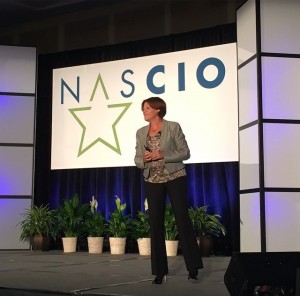You have been living in a world of lies since kindergarten. From the time you thought paste was a member of the food pyramid, you were taught that there is no “I” in team. And while the spelling bee members of your team were correct — the letter I is not actually in the word — those sticklers are missing the bigger point, because there are plenty of Is in team. In fact, all teams are made up of Is — or individuals.
 Each individual team member brings a different voice, needs and passions to the project. “As a leader, it’s your job to find a way to connect to each of your employees, you need to listen intently to the possibilities each team member brings to the table,” said Michelle Stacy, Former President of Green Mountain’s Keurig Division, Visionary Corporate Leader on Growth, Innovation and Culture. Stacy was the opening keynote for the National State Chief Information Officer’s mid-year conference in Alexandria, Virginia.
Each individual team member brings a different voice, needs and passions to the project. “As a leader, it’s your job to find a way to connect to each of your employees, you need to listen intently to the possibilities each team member brings to the table,” said Michelle Stacy, Former President of Green Mountain’s Keurig Division, Visionary Corporate Leader on Growth, Innovation and Culture. Stacy was the opening keynote for the National State Chief Information Officer’s mid-year conference in Alexandria, Virginia.
By focusing on the individual rather than the overall group, a leader is more able to address the specific areas of concern.
According to Gallup, only 30 percent of the workforce is actively engaged. That means that more than 70 percent of the workforce is either not engaged, or worse, they are actively not engaged. In order to be an effective leader managers need to get every single individual employee engaged with the mission. “You are always going to have that 20-30 percent of gold stars, or employees that are going to rise through the ranks quickly. But you can engage your entire staff. You can make sure that everyone is moving in the same direction, towards the right mission,” explained Stacy. “Each individual has the potential and power to contribute. You need to empower them.”
Stacy argued leadership is about balancing the head and the heart. “As leaders we spend a lot of time on the head part. We focus on strategy and how to measure goals, but we don’t spend a lot of time on people. What motivates them, what makes them engaged? You can’t be an effective leader unless you focus both on the head and the heart.”
And leaders need to focus on people before process improvements because people are the only asset that can create, are renewable and can produce results. “You have to harness the power of people. Processes don’t create. Systems don’t create. People are the only ones that can help you innovation,” explained Stacy.
Stacy’s six components to effective heart leadership:
1. Balance the head and heart – What do we do when people don’t listen to us? We say things louder. As humans we have an innate desire to be heard, but if you are a leader your volume and body language say just as much as your words. You don’t want your employees scared of you, or slinking away or not voicing an opposing opinion. Leaders need to be constantly aware of your body language.
2. Be in relationships with your people – It may sound strange, but in order for a working relationship to be effective it has to be personal. Do you watch the same television show? Have kids a similar age, like the same sports team? Leaders need to find a point of connection. The more your employees understand you, the easier it is to communicate and get things done.
3. Let people see the whole – Similarly, leaders have to bring their whole self to work. That doesn’t mean you have to share everything, but you have to share something. What makes you tick? What bothers you most? If you share, it gives your staff the freedom to be themselves too.
4. Be honest – Simply put honesty leads to authenticity. A vulnerable leader is a good one. Be willing to share where you don’t know things. A wonderful way to engage your team is to say, ‘I don’t know this. Can you help me?’ Share your vulnerabilities and uncertainties, be real, be humble, and laugh at yourself.
5. Balance authority and authenticity – Remember the power of your position as a leader. Make sure you are clear when you are suggesting something or demanding it. Oftentimes employees will take a suggestion as an order. You can make or break a person’s day simply by the way you interact with them. If you are checking your email during an employee’s presentation they know you are not engaged.
6. Bring the star out in each individual – Be wary of the way we review talent in identifying the 20% high potential stars we leave behind too many gems. Sure, not everyone is going to make it to the C-Suite, but don’t count someone out because they are not part of the 20% of engaged employees. Maybe the employee is not being used properly. Look for possibility and moments of greatness. Today’s rock is tomorrow’s rockstar.
Mrs. Summers (my kindergarten teacher) probably didn’t mean any harm when she told us there was no I in team. She wanted us to work together and stop throwing blocks at each others head. But for leaders to really move teams forward they have to focus on the individual because the ability to get every single individual engaged in the overall goal.
“Leading successful teams is not about having the best talents,” said Stacy. “It’s about the best motivated talent clearly directed. That makes the fantasy team.”





Leave a Reply
You must be logged in to post a comment.